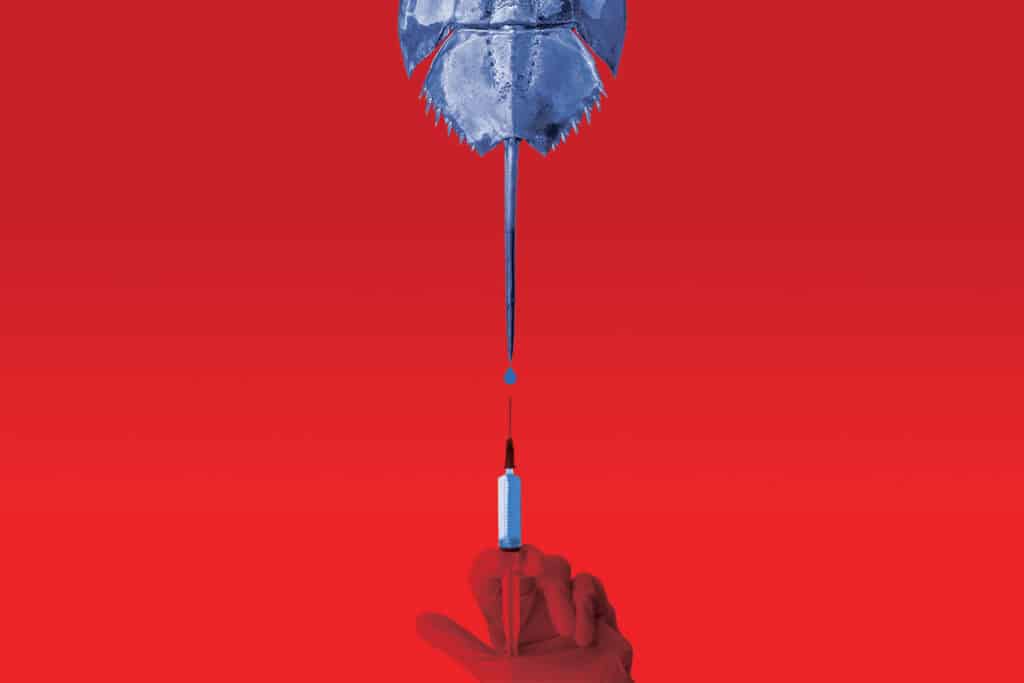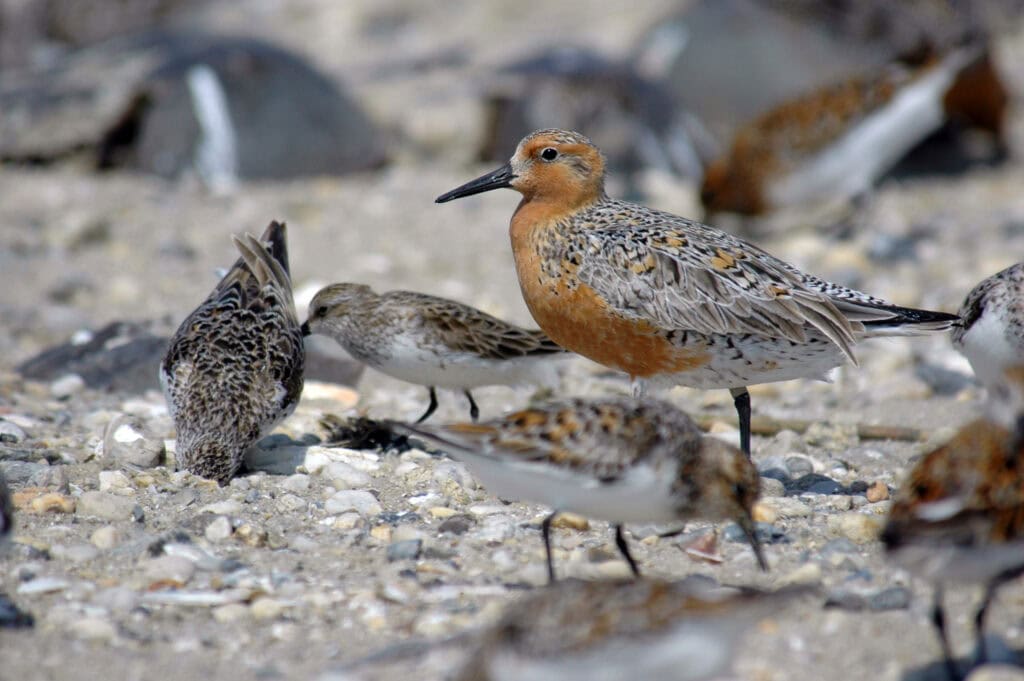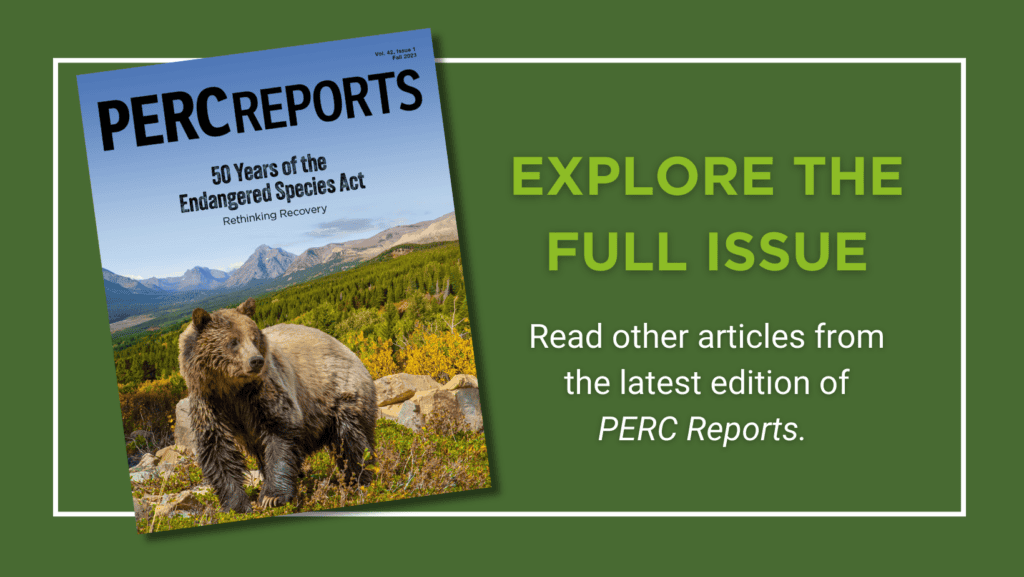
This special issue of PERC Reports examines the Endangered Species Act with an eye toward improving the incentives for species recovery. Read the full issue.
A row of quart-sized glass jars line a counter, slowly being filled with something akin to blue ooze. What looks like it could be a small-batch toothpaste factory is instead a lab where horseshoe crabs are bled for the unique properties of their bright blue blood. The arthropod’s blood contains a chemical that can precisely detect bacterial toxins and was used to create a medical test in the 1970s. For about half a century, the so-called LAL test has been the preferred method to make sure injectable drugs like Covid vaccines and medical devices like IV bags are safe for human use.
A little more than half of all LAL tests are performed by Massachusetts-based Charles River Laboratories. “We are almost the last line of defense before these drugs leave the manufacturing area and make it to a patient,” Senior Vice President Foster Jordan told the Associated Press in 2021. “If it touches your blood, it’s been tested by LAL.”
Despite the test being integral to medical supply chains, the technique has its critics, partly due to the importance of horseshoe crabs to a different type of supply chain. The crabs’ eggs provide a crucial food source to migratory birds, including the federally protected red knot. Conservation groups claim that the bleeding process kills up to 30 percent of bled crabs and lowers the species’ spawning rates. The process is akin to a human donating blood, and most bled crabs are returned to the ocean. Several East Coast states also allow for regulated harvest of horseshoe crabs that are used as bait by commercial fishers.
A man-made alternative to the LAL test holds the promise of alleviating the need to collect and bleed horseshoe crabs entirely—but only if it becomes widely adopted. A synthetic version of the substance was first developed two decades ago and has already begun to replace the use of the blue blood, albeit in limited contexts. The new method demonstrates the promise—and challenges—of harnessing innovation to spare natural resources, whether it be imperiled birds that feed on horseshoe crabs, wildlife resources like shark fins and rhino horn that are prized for their uniqueness, or land itself.
To Bleed or Not to Bleed
The development of the LAL test itself helped spare members of an entirely common species. Prior to the test, rabbits had been used to screen for deadly toxins in medicines, and hundreds of thousands of them were killed annually under the old approach. Today, fewer crabs being removed from beaches to be bled would presumably leave more to provide roe for red knots and other migratory birds. Several conservation groups have trumpeted the potential for a synthetic version of LAL, known as recombinant factor C, or rFC, to obviate the need for blood donations from horseshoe crabs. The U.S. Fish and Wildlife Service notes that since the 1980s the red knot’s population has declined by 75 percent in certain areas, “largely due to declines in one of its primary food resources—horseshoe crab eggs in Delaware Bay.” The agency listed the bird as threatened in 2014. It stops to feed on the crabs’ eggs in the bay and several places, including beaches in South Carolina, during its annual migration from Tierra del Fuego in South America to the Arctic, where it breeds. Some fly more than 18,000 miles each year.

“Transitioning away from the bleeding of the horseshoe crabs to a readily available synthetic alternative is a win-win situation—for the crabs, the birds, and people,” Ryan Phelan, executive director of Revive and Restore, said at a past event to promote the use of rFC. The organization promotes various ways to use biotechnology to rescue endangered species and even revive extinct ones. Pehlan noted that adopting rFC at scale would ensure “the safe and sustainable manufacturing of pharmaceuticals while sparing the crabs and the birds that depend on them.”
One reason the method has not been widely adopted is that U.S. Pharmacopoeia, an influential nonprofit that sets legal standards for the composition of medicines, has so far declined to declare rFC equivalent to LAL. So while a pharmaceutical company can opt to use rFC to screen drugs, it must go through extra work to validate that the test is equivalent to LAL every time it uses it, “a burdensome step not supported by the peer-reviewed literature or fundamental biotechnology science,” as Revive and Restore puts it.
In 2018, drugmaker Eli Lilly began to use rFC to screen a migraine treatment. It was the first medicine tested with rFC to be approved by the Food and Drug Administration. In 2020, the European Pharmacopoeia endorsed the test for use, stating that a “test for bacterial endotoxins using rFC can be used in the same way as LAL-based methods.”
“It’s actually been cost advantageous for us,” Jay Bolden, an Eli Lilly scientist, recently told NPR. “Then from a quality perspective, we have seen that it is better.”
How to Spare Species
If eventually adopted at large scale, the synthetic test could become another in the line of innovations that help spare species, a feat that has proved difficult for some types of wildlife despite multiple highly touted efforts.
Several attempts to create synthetic rhino horn have so far struggled to achieve their aim of disrupting poaching by introducing uncertainty into the illicit market for horns, largely due to fierce resistance from skeptical wildlife nonprofits. PERC Research Fellow Michael ’t Sas-Rolfes, who has studied the topic deeply, noted in one co-authored paper that “a legal market for synthetic substitutes is more likely to reduce poaching when demand is less sensitive to price changes.” He points out, however, that this nuance has been ignored by international law enforcement, who worry about the potential for laundering illegally harvested horns. Likewise, projects to disrupt elephant ivory markets in similar ways have yet to take off.
Despite the power of human innovations to deliver such huge conservation benefits, the upside remains overlooked in many popular contexts.
By contrast, imitation shark fin has fared better. An estimated 100 million sharks are killed globally each year, many finned to use in a soup traditionally served at Chinese weddings. Adoption of alternatives, often made from mung beans or seaweed derivatives, seems to have helped create uncertainty in the fin market and contributed to decreased demand for the real thing over recent years. One academic survey noted that the biggest factor for the decline in shark fin consumption in Beijing restaurants was the “preponderance of fake shark fins on the market,” which undercut consumer trust.
A seeming advantage for rFC—and horseshoe crabs and red knots by extension—is that it’s not a luxury good. Most buyers of rhino horn or shark fin seek the status conferred by purchasing or consuming the real thing, whether legal or not. A product whose value comes mainly from its functionality might find an easier time displacing its wild analog. In that vein, rFC resembles more mundane, if essential, ways that humans spare nature by using substitutes. Linus Blomqvist, a 2023 visiting fellow at PERC, has succinctly summed up many of them in writing for the Breakthrough Institute:
“Farmed instead of wild meat takes pressure off wild animal populations. Aquaculture increasingly takes pressure off wild fish stocks as feed-to-meat conversion ratios improve and plant-based feeds substitute fish-based feeds. Forests are spared when humans move from reliance on wood fuel to modern energy. Replacing organic with synthetic fertilizer eliminates the need to allocate land for nitrogen fixation. Substituting synthetic fiber and rubber for their natural counterparts reduces the land required to produce these goods. Tractors substitute draft animals, freeing up land previously dedicated to growing animal feed.“
Despite the power of human innovations to deliver such huge conservation benefits, the upside remains overlooked in many popular contexts. Lately, the lack of appreciation for the phenomenon appears in popular narratives about pushes for clean energy. For instance, the Los Angeles Times recently devoted in-depth reporting to explore how solar power buildouts might impact habitat for wildlife. The report, however, largely ignored simpler and arguably more effective ways to conserve habitat for desert tortoises and the like. Careful siting of solar panels and other prudent land-use decisions can certainly minimize disturbances to habitat for imperiled species. But, to take one example, advances in nuclear power could potentially spare much more habitat: Not only is nuclear energy emissions free, it requires approximately one-tenth the land area as solar power. Human blood contains iron, which is used to bind with oxygen in the bloodstream. Instead of iron, horseshoe crabs use copper, which is what gives their blood its blue color. If rFC gains traction in U.S. pharmaceutical testing, then perhaps one day there will be no more jars filled with blue ooze lining lab counters, and red knots and other migratory birds will have one fewer competitor for in-transit meals.




